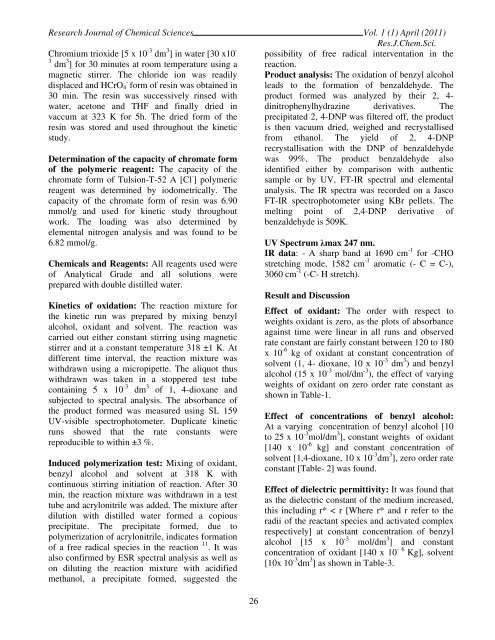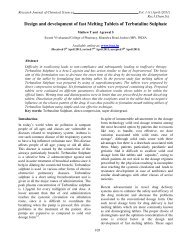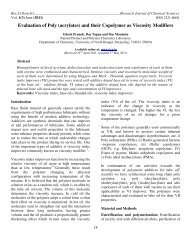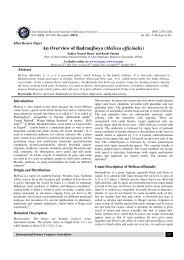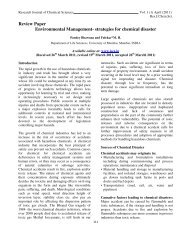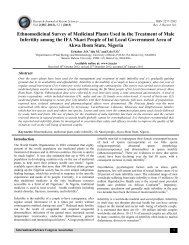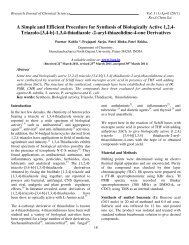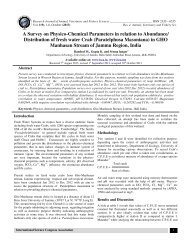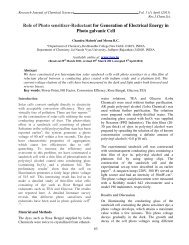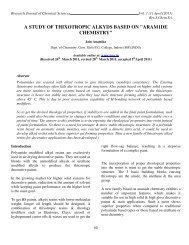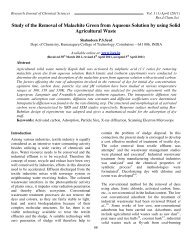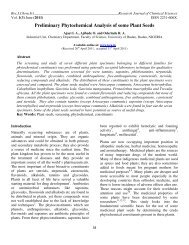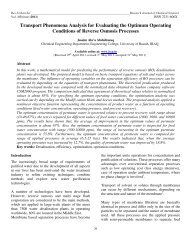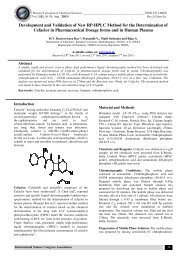Mechanistic study of chromium (VI) catalyzed oxidation of ... - ISCA
Mechanistic study of chromium (VI) catalyzed oxidation of ... - ISCA
Mechanistic study of chromium (VI) catalyzed oxidation of ... - ISCA
Create successful ePaper yourself
Turn your PDF publications into a flip-book with our unique Google optimized e-Paper software.
Research Journal <strong>of</strong> Chemical Sciences Vol. 1 (1) April (2011)<br />
Res.J.Chem.Sci.<br />
Chromium trioxide [5 x 10 -3 dm 3 ] in water [30 x10 -<br />
3 dm 3 ] for 30 minutes at room temperature using a<br />
magnetic stirrer. The chloride ion was readily<br />
-<br />
displaced and HCrO 4 form <strong>of</strong> resin was obtained in<br />
30 min. The resin was successively rinsed with<br />
water, acetone and THF and finally dried in<br />
vaccum at 323 K for 5h. The dried form <strong>of</strong> the<br />
resin was stored and used throughout the kinetic<br />
<strong>study</strong>.<br />
Determination <strong>of</strong> the capacity <strong>of</strong> chromate form<br />
<strong>of</strong> the polymeric reagent: The capacity <strong>of</strong> the<br />
chromate form <strong>of</strong> Tulsion-T-52 A [Cl - ] polymeric<br />
reagent was determined by iodometrically. The<br />
capacity <strong>of</strong> the chromate form <strong>of</strong> resin was 6.90<br />
mmol/g and used for kinetic <strong>study</strong> throughout<br />
work. The loading was also determined by<br />
elemental nitrogen analysis and was found to be<br />
6.82 mmol/g.<br />
Chemicals and Reagents: All reagents used were<br />
<strong>of</strong> Analytical Grade and all solutions were<br />
prepared with double distilled water.<br />
Kinetics <strong>of</strong> <strong>oxidation</strong>: The reaction mixture for<br />
the kinetic run was prepared by mixing benzyl<br />
alcohol, oxidant and solvent. The reaction was<br />
carried out either constant stirring using magnetic<br />
stirrer and at a constant temperature 318 ±1 K. At<br />
different time interval, the reaction mixture was<br />
withdrawn using a micropipette. The aliquot thus<br />
withdrawn was taken in a stoppered test tube<br />
containing 5 x 10 -3 dm 3 <strong>of</strong> 1, 4-dioxane and<br />
subjected to spectral analysis. The absorbance <strong>of</strong><br />
the product formed was measured using SL 159<br />
UV-visible spectrophotometer. Duplicate kinetic<br />
runs showed that the rate constants were<br />
reproducible to within ±3 %.<br />
Induced polymerization test: Mixing <strong>of</strong> oxidant,<br />
benzyl alcohol and solvent at 318 K with<br />
continuous stirring initiation <strong>of</strong> reaction. After 30<br />
min, the reaction mixture was withdrawn in a test<br />
tube and acrylonitrile was added. The mixture after<br />
dilution with distilled water formed a copious<br />
precipitate. The precipitate formed, due to<br />
polymerization <strong>of</strong> acrylonitrile, indicates formation<br />
<strong>of</strong> a free radical species in the reaction 11 . It was<br />
also confirmed by ESR spectral analysis as well as<br />
on diluting the reaction mixture with acidified<br />
methanol, a precipitate formed, suggested the<br />
2<br />
26<br />
possibility <strong>of</strong> free radical interventation in the<br />
reaction.<br />
Product analysis: The <strong>oxidation</strong> <strong>of</strong> benzyl alcohol<br />
leads to the formation <strong>of</strong> benzaldehyde. The<br />
product formed was analyzed by their 2, 4-<br />
dinitrophenylhydrazine derivatives. The<br />
precipitated 2, 4-DNP was filtered <strong>of</strong>f, the product<br />
is then vacuum dried, weighed and recrystallised<br />
from ethanol. The yield <strong>of</strong> 2, 4-DNP<br />
recrystallisation with the DNP <strong>of</strong> benzaldehyde<br />
was 99%. The product benzaldehyde also<br />
identified either by comparison with authentic<br />
sample or by UV, FT-IR spectral and elemental<br />
analysis. The IR spectra was recorded on a Jasco<br />
FT-IR spectrophotometer using KBr pellets. The<br />
melting point <strong>of</strong> 2,4-DNP derivative <strong>of</strong><br />
benzaldehyde is 509K.<br />
UV Spectrum λmax 247 nm.<br />
IR data: - A sharp band at 1690 cm -1 for -CHO<br />
stretching mode, 1582 cm -1 aromatic (- C = C-),<br />
3060 cm -1 (-C- H stretch).<br />
Result and Discussion<br />
Effect <strong>of</strong> oxidant: The order with respect to<br />
weights oxidant is zero, as the plots <strong>of</strong> absorbance<br />
against time were linear in all runs and observed<br />
rate constant are fairly constant between 120 to 180<br />
x 10 -6 kg <strong>of</strong> oxidant at constant concentration <strong>of</strong><br />
solvent (1, 4- dioxane, 10 x 10 -3 dm 3 ) and benzyl<br />
alcohol (15 x 10 -3 mol/dm -3 ), the effect <strong>of</strong> varying<br />
weights <strong>of</strong> oxidant on zero order rate constant as<br />
shown in Table-1.<br />
Effect <strong>of</strong> concentrations <strong>of</strong> benzyl alcohol:<br />
At a varying concentration <strong>of</strong> benzyl alcohol [10<br />
to 25 x 10 -3 mol/dm 3 ], constant weights <strong>of</strong> oxidant<br />
[140 x 10 -6 kg] and constant concentration <strong>of</strong><br />
solvent [1,4-dioxane, 10 x 10 -3 dm 3 ], zero order rate<br />
constant [Table- 2] was found.<br />
Effect <strong>of</strong> dielectric permittivity: It was found that<br />
as the dielectric constant <strong>of</strong> the medium increased,<br />
this including r* < r [Where r* and r refer to the<br />
radii <strong>of</strong> the reactant species and activated complex<br />
respectively] at constant concentration <strong>of</strong> benzyl<br />
alcohol [15 x 10 -3 mol/dm 3 ] and constant<br />
concentration <strong>of</strong> oxidant [140 x 10 - 6 Kg], solvent<br />
[10x 10 -3 dm 3 ] as shown in Table-3.


